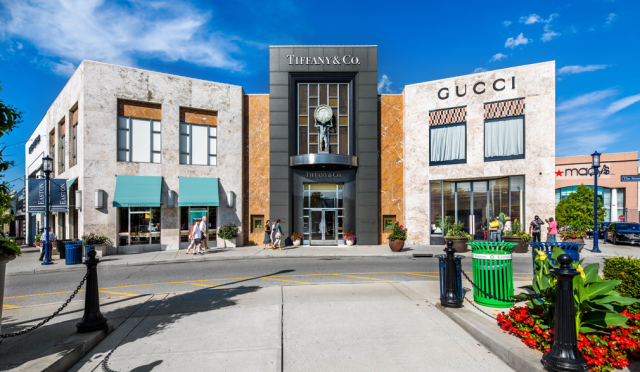Expanding luxe brands are turning up in malls and new locations like this one in Columbus’s Easton Town Center.
Al Urbanski|Real Estate Editor & Manager
Source: chainstoreage.com, September 2023
During the brick-and-mortar shutdowns of 2020, sales of luxury goods dipped by 8.5% to below $60 billion in the United States. But, inflation be darned, well-heeled Americans made up for lost Swiss watches and fine leather goods in 2022.
The United States led the world in luxury consumption last year with expenditures totaling $70 billion, according to JLL’s “Luxury Report 2023.” That amount represented one-third of worldwide luxury sales–and solid gold registers are expected to keep ringing. The market data company Statista predicts another $5 billion increase this year and sales topping $80 billion by 2027.
Receipts at top luxury goods providers rose by double-digits across the board last year. LVMH (whose brand portfolio includes Louis Vuitton, Sephora Dior, Tiffany and many others) tallies were up by 23%, Richemont (Cartier, Van Cleef) rose by 19%, and Kering Group (Gucci, Saint Laurent) topped its 2021 take by 15%.
Sales velocity is expected to stay at a high level as these traditional urban high street brands spread out to new locales in bigger spaces. The brands moved into more than 650,000 sq. ft. of space last year and, according to JLL, nearly 40% of the new stores opened in high-end malls.
The average luxury store is bigger than it used to be; JLL has computed that the average new luxury lease size is greater than 5,000 sq. ft. The stores are also covering a wider swath of the American market.
Gucci, which started at New Jersey’s American Dream mall with a boutique inside Saks Fifth Avenue is moving into to a 10,000-sq.-ft. space in The Avenue luxury wing. At Scottsdale Fashion Square in Arizona, Hermés signed a lease for an 11,000-sq.-ft. location.
Alexander McQueen chose malls for all three of its openings last year in Atlanta (Phipps Plaza), Boston (Copley Place), and Charlotte (NorthPark). Dior made similar moves opening at the Mall at Millennia in Orlando, Detroit’s Somerset Collection, and the Domain in Austin.
While more than half of new store openings took place in New York and California last year, luxury brands are beginning to strike out into new markets. Balenciaga, Dior, and Gucci opened new stores in Detroit. Last year Gucci also opened its first Ohio location at Easton Town Center in Columbus, joining a luxe lineup that includes Louis Vuitton, Tiffany & Co, and Tory Burch.
Luxury retail’s expanse may soon be slowed by market conditions that most retail real estate predict will continue to plague the industry for another year. New construction and vacancy rates remain at historic lows in the 4% range.
Class A malls with 6% vacancy rates, maintains JLL, may continue to be luxury’s chief expansion venues for the near future.

